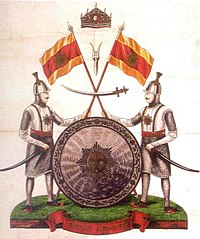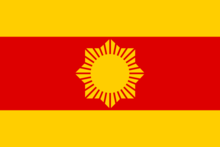This article needs additional citations for verification. (March 2018) |
| House of Jamwals | |
|---|---|
 The Crown at the top. A katar or ceremonial dagger sat below it. Two soldiers holding the flags. An image of the sun symbolising the Suryavansha Kshatriya lineage from Lord Rama | |
 Flag of Dogra Dynasty | |
| Country | Jammu and Kashmir (princely state) |
| Founded | 16 March 1846 |
| Founder | Gulab Singh |
| Current head | Karan Singh |
| Final ruler | Hari Singh Karan Singh (as Sadr-i-Riyasat) |
| Estate(s) | Mubarak Mandi Palace Amar Mahal Palace Hari Niwas Palace Sher Garhi Palace |
| Deposition | 1952 |
The Dogra dynasty[1][2] of Dogra Rajputs from the Shivalik hills created Jammu and Kashmir through the treaties with the East India Company following the First Anglo-Sikh war. Events led the Sikh Empire to recognise Jammu as a vassal state in 1820, and later the British added Kashmir to Jammu with the Treaty of Amritsar in 1846. The founder of the dynasty, Gulab Singh, was an influential noble in the court of the Sikh emperor Maharaja Ranjit Singh, while his brother Dhian Singh served as the prime minister of the Sikh Empire. Appointed by Ranjit Singh as the hereditary Raja of the Jammu principality, Gulab Singh established his supremacy over all the hill states surrounding the Kashmir Valley. After the First Anglo-Sikh War in 1846, under the terms of the Treaty of Lahore, 1846, the British East India Company acquired Kashmir from the Sikh Empire and transferred it to Gulab Singh, recognising him as an independent Maharaja. Thus, Jammu and Kashmir was established as one of the largest princely states in India,[a] receiving a 21-gun salute for its Maharaja in 1921. It was ruled by Gulab Singh and his descendants until 1947.[5][6]
The last ruling Maharaja of Jammu and Kashmir was Hari Singh, who contributed troops to the British war effort in World War II and served on Churchill's Imperial War Cabinet.[7] Following the Partition of India in 1947, Hari Singh faced a rebellion in the western districts of the state and a Pakistan-supported tribal invasion, leading him to accede to the Union of India and receive military assistance. Pakistan contested the accession, giving rise to the enduring Kashmir conflict.
With India's support, the popular leader of Jammu and Kashmir, Sheikh Mohammad Abdullah, forced the Maharaja to abdicate in favour of his son, Yuvraj (Crown Prince) Karan Singh, who subsequently accepted the position of a constitutional head of state (Sadr-i-Riyasat) and voluntarily gave up the title of Maharaja.[8]
- ^ "Dogra dynasty | India | Britannica.com". britannica.com. Retrieved 20 August 2015.
- ^ Shome, Ayan (1 November 2014), Dialogue & Daggers: Notion of Authority and Legitimacy in the Early Delhi Sultanate (1192 C.E. – 1316 C.E.), Vij Books India Pvt Ltd, pp. 184–, ISBN 978-93-84318-46-8
- ^ Ernst, Waltraud; Pati, Biswamoy (2007). India's Princely States: People, Princes and Colonialism. Routledge. p. 68. ISBN 9781134119882.
- ^ Kaminsky, Arnold P.; Ph.D, Roger D. Long (2011). India Today: An Encyclopedia of Life in the Republic [2 volumes]. ABC-CLIO. p. 378. ISBN 9780313374630.
- ^ Yakub (1 September 2009). "TREATY OF AMRITSAR" (PDF). Archived from the original (PDF) on 26 August 2014. Retrieved 20 August 2015.
- ^ Rai, Mridu (2004). Hindu Rulers, Muslim Subjects: Islam, Rights, and the History of Kashmir. Princeton University Press. pp. 27, 133. ISBN 0-691-11688-1.
- ^ Schofield, Kashmir in Conflict 2003, p. 22.
- ^ Lyon, Peter (2008), Conflict Between India and Pakistan: An Encyclopedia, ABC-CLIO, pp. 150–151, ISBN 978-1-57607-712-2
Cite error: There are <ref group=lower-alpha> tags or {{efn}} templates on this page, but the references will not show without a {{reflist|group=lower-alpha}} template or {{notelist}} template (see the help page).